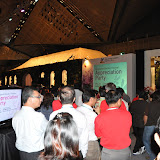TUESDAY 13 JULY 2010- CYRENE REEF. Having heard a lot of Cyrene's marine life we were excited to get this opportunity to go. Even though we had to get up at 3.30 am to meet the schedule it was more than worthwhile.On landing, it was amazing to be standing almost as if in the middle of the sea surrounded by the bright lights of the nearby petro-chemical facilities. We had little time to admire the profusion of lights as we were reminded that we have only a couple of hours before the tide will reclaim the reefs.
As this was our first visit Chay Hoon took us under her wing. Looking down on the sand we were greeted by the outline of numerous sand dollars and before we could count the dollars we saw lots of Common Sea Stars. While taking photographs of the usual 5-arm stars we also saw a 4-arm and a 6-arm. While marvelling at such a lot of stars we could see a few meters further an amazing array of knobbly sea stars of various sizes, shapes and colours. As we took photographs of each knobbly we discovered each star is unique which meant we could not help but take photo after photo of every knobbly we came across. Our attention was also captured by other marine life that share the sea grass area. We saw some sea cucumbers, a flathead/crocodile fish, flatworm, a red eye purple crab, the poisonous Mosaic crab, some spiny fishes cleverly hidden in the jagged rocks. As we carefully locate the sandy parts amongst the rocky and grassy terrain to walk, we saw a beautiful long horn cow fish in a pool and later a discodoris nudibranch. There were carpet and peacock anemones and lots of zoanthids. As the dawn was breaking we switched off our headlights and made further discoveries. A few more interesting finds by Chay Hoon were the cushion stars and the star of our trip - the pentaceraster sea star which apparently was a long way from its usual habitat in the Indian ocean, but a most welcome discovery for our first trip.

Cyrene’s beautiful marine live that we saw on this trip (thanks to Ria) is unbelievable, given the heavy industry and container traffic at such close proximity of the reefs. Truly nature and industrialisation can co-exist. Any visitor would be mesmerized by what we saw.
Cyrene is a "gem" which shows that Man and Nature can co-exist as we progress, through our actions to preserve Nature whenever we can.



